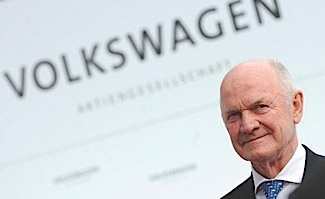 Volkswagen head Ferdinand Piech has now ended the silence that had fallen on the automotive industry following Daimler’s announcement of its plans to withdraw from using HFO-1234yf in future vehicles.
Volkswagen head Ferdinand Piech has now ended the silence that had fallen on the automotive industry following Daimler’s announcement of its plans to withdraw from using HFO-1234yf in future vehicles.
According to the site R744.com, Piech told journalists that, “The right refrigerant is CO2. It does not burn, for sure. Until this comes, we will continue using the proven refrigerant R-134a.”
Daimler, the manufacturer of Mercedes-Benz vehicles, had said Sept. 25 that it would not be using the new HFO refrigerant R-1234yf in its vehicle air conditioning systems. Instead, it says it plans to continue using R-134a.
The German car and truck manufacturer has raised new safety concerns with usage of the internationally recognized refrigerant replacement for R-134a following its own independent safety tests.
While concerns had been raised in the past — particularly in Germany — as to the issue of its “mild” flammability, the climate-friendly R-1234yf was to be implemented worldwide in 2013 models.
The U.S. Environmental Protection Agency (EPA) had perceived the new refrigerant to be safe. Its findings were the result of numerous laboratory and crash tests carried out by international vehicle manufacturers and independent institutions.
But Daimler said it has carried out a series of additional tests on the new refrigerant as part of a new real-life test scenario developed in-house, which goes above and beyond the legally prescribed requirements.
“In the new real-life test scenario, the refrigerant is dynamically dispersed at high pressure near to hot components of the test vehicle’s exhaust system,” said the report. “This corresponds to a serious head-on collision in which the refrigerant line is severed and the reproducible results demonstrate that refrigerant, which is otherwise difficult to ignite under laboratory conditions, can indeed prove to be flammable in a hot engine compartment.”
Daimler said that similar tests carried out with the current R-134a refrigerant did not result in ignition.
“Due to the new findings of this study and the high safety demands at Mercedes-Benz, this chemical will not be used in its products,” says a company statement.
“The company therefore wishes to continue to use the proven and safe R-134a refrigerant in its vehicles. Daimler has already informed the relevant authorities of these facts and will also make the results of this investigation available to all relevant associations as well as to other vehicle manufacturers,” it said.
The ‘Smoking Gun’?
Daimler welcomed VW’s decision to not use R-1234yf. An official Daimler video has been released that the company says proves that under real-life conditions, R-1234yf starts burning after two seconds, releasing highly toxic substances.
You can access the video at: http://r744.com/web/assets/video/1234yf-vs-134a-fire.mp4.
According to Daimler, a blue flash fire appears after about two seconds, indicating that the R-1234yf is burning. Released by a remotely controlled valve in the refrigerant piping, it releases highly toxic substances before the fire is extinguished after 12 seconds.
Within this short time period the flames’ yellow color indicate that the fire has already spread to the plastic parts of the motor compartment, and the front windshield is corroded by the aggressive acid. 
This test, conducted by Daimler on a Mercedes B 180, was said to have occurred under real-life conditions. The automaker says it proves that the refrigerant so far assumed to be “mildly flammable” is indeed ignited instantly, as compared to the conventional refrigerant R-134a also shown in the test.
One of the major arguments — that the flammability concerns for R-134a and R-1234yf would be comparable and in fact negligible — falls apart, sparking a discussion if the approval for R-1234yf now has to be revised.
Daimler said that this test is replicable at any time and to stress its message, the carmaker repeated the test live in front of other automotive companies and public authorities, as well as to the chemical maker Honeywell, which currently holds a global patent on the R-1234yf refrigerant.
Following a meeting with Mercedes-Benz, Honeywell reported that it did not see any evidence that the car manufacturer’s findings into the safety of R-1234yf had added any substantial new information to previous comprehensive risk assessments.
“The Mercedes-Benz testing was conducted without the participation of any reputable third party and without consultation with others in the industry,” said a Honeywell spokesperson.
Honeywell then pointed out that HFO-1234yf was the subject of comprehensive testing conducted over a three-year period under the Cooperative Research Program (CRP) of SAE International using proven, standard methods for evaluating new products and materials in automobiles.
“That testing, which was sponsored by 15 global automakers including all leading German automakers, concluded that HFO-1234yf is safe for use in automobile applications,” said a Honeywell spokesman.
“While Honeywell appreciates Daimler’s willingness to discuss the results of its in-house tests, we do not see any evidence that the findings have added any substantial new information to the comprehensive risk assessments conducted under the CRP.”
The refrigerant manufacturer maintains that in today’s automobiles, there are several useful materials under the hood that are more flammable, including brake and transmission fluids, coolant, lubricants and gasoline.
“Automakers can safely use these flammable materials through design that minimizes the risks,” says Honeywell.
“In fact, OEMs have already taken appropriate vehicle design steps to ensure the safe use of HFO-1234yf even under extreme conditions, as they do for other flammable materials.
Honeywell said it had a constructive dialogue with Daimler and asked them to review their designs to determine the necessary modifications required to further minimize any flammability risks.
The refrigerant maker also offered its engineering expertise to work alongside Daimler’s engineers to develop a solution for their vehicles and meet the Jan. 1, 2013, deadline for the European Union’s Mobile Air Conditioning Directive to replace R-134a in vehicles.
“We regret the position that Daimler has taken in isolation and believe that it does not reflect the industry’s collaborative and transparent testing processes, which have ensured the safe implementation of many innovative materials within automobiles,” Honeywell said.
Back to the Drawing Board?
In response to Volkswagen’s recent press statement that “CO2 is the right refrigerant,” SAE International president Frank Klegon has again invited all automobile manufacturers to join in an industry collaborative effort to fully evaluate the technical aspects of the use of CO2 as an automotive air conditioning refrigerant.
SAE International has unquestioned expertise in the research, analysis and application of a variety of automotive refrigerants. 
In the last decade, more than 10 major SAE CRP projects have provided forums for subject matter experts from around the industry to meet, discuss and agree on advantages and disadvantages of various alternative refrigerants, as well as the management of accompanying risks.
“The implementation of CO2 as an automotive refrigerant is not without technical challenges,” Klegon said.
The U.S. EPA has published its concerns regarding the use of CO2 as a mobile air conditioning refrigerant for passenger cars. Under its Significant New Alternatives Policy (SNAP) program published this year, the EPA found that the use of CO2 posed risks that were lower than or comparable to the risks posed by other acceptable substitutes.
However, it specified the use of fittings with specific dimensions to deal with the higher-pressure refrigerant. In addition, in the event of a CO2 leak into the passenger area, it placed maximum short-term exposure limits of 3% (30,000 ppm) averaged over 15 minutes with a ceiling limit of 4% in the passenger breathing zone.
EPA reports have revealed that exposures over 4% (40,000 ppm) CO2 are likely to cause discomfort and signs of intoxication that could impair the driver’s response to road and driving conditions, and could create safety and health risks to the passengers.
While Daimler is keeping open all options for the best refrigerant to be used in the future, among them CO2, VW has made clear that the natural refrigerant is the direction to go, regardless of the SNAP findings.
As a reaction to VW’s announcement, Daimler told the press that “we are happy that VW follows us in our evaluation of the risks associated to the new refrigerant” while also clarifying that “if the VW corporation excludes the use of R-1234yf, we would welcome this decision. We are currently investigating different options for a different refrigerant, and this includes also the use of CO2.”
Sources: Honeywell, SAE International, PR Newswire and R744.com
